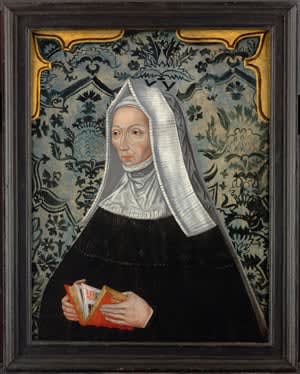
English School
Portrait of Margaret Beaufort (1443-1509), Late 16th Century
Oil on panel
21 2/3 x 17 inches (55 x 43 cm)
Philip Mould & Co.
To view all current artworks for sale visit philipmould.com As the most senior Lancastrian descendant in the late fifteenth century, Margaret Beaufort was the dominant force behind her son Henry...
To view all current artworks for sale visit philipmould.com
However, the circumstances of Margaret’s life at her birth could hardly have signalled that she would one day become the Queen Mother. Her father, John Beaufort, Duke of Somerset, was a disgraced military commander who died within one year of her birth, and she was placed as a ward (that is, with control over her affairs or estates) under the Marquess of Suffolk, who contracted her to be married to his son at the age of six. But in 1453 her kinsman the Lancastrian Henry VI dissolved the marriage, and decided instead that she should marry Edmund Tudor, the son of Catherine of Valois, the Queen of Henry V. Margaret’s royal status was thus further reinforced, along with that of any of her children.
Margaret gave birth to Henry Tudor, at the age of thirteen, as a widow. Edmond Tudor had died a few months previously of the plague. Margaret’s future looked even bleaker after the murder of Henry VI in 1471 and the accession of the Yorkist Edward IV. Her son now took on an even greater significance as the next male Lancastrian claimant, and, fearing for his safety, Margaret encouraged Henry to flee to France. Margaret was now in desperate need of the security of another marriage, and in 1472 she married Thomas, 2nd Baron Stanley, a powerful magnate and, at that time, a Yorkist supporter. It appears that for the remainder of Edward’s reign Margaret accepted the Yorkist supremacy, but the accession of Richard III and his murder of the Princes in the Tower so repulsed her that she began to actively plot his overthrow and advance her son’s claim to the crown. Her involvement in the Duke of Buckingham’s failed rebellion of 1484 was discovered, and she was forced to hand over all her estates to the control of her husband, who in turn agreed to be her effective gaoler and keep her under constant supervision.
Nevertheless, Margaret continued to push for Richard’s overthrow. She played a leading role in the negotiations of her son’s marriage to Elizabeth of York, a crucial match which would signify politically the union in her son of the two houses of York and Lancaster, and which significantly increased Henry’s claim to the throne. Following Henry’s victory over Richard at the Battle of Bosworth Field in 1485, Margaret’s role was transformed, not least because she herself arguably held a stronger claim to the crown than her son, there being no English law that forbade the right of women to the throne. She signed her letters ‘Margaret R’ for example, and was granted enormous households in London and Northamptonshire, where she acted as Henry’s effective deputy in the East Midlands. Margaret was highly educated, and was an established author and translator in her own right. She published a number of religious tracts, such as The Imitation of Christ, and patronised a number of centres of learning, including St John’s College Cambridge. Towards the end of her life, Margaret devoted herself to a life of prayer, particularly after the death of Lord Stanley in 1504.
This portrait would probably have been commissioned as part of a set of corridor portraits in the later sixteenth century during the reign of Elizabeth I. Such sets were designed to emphasise a family’s loyalty to the Tudor regime, and would invariably have included images of Henry VII and Henry VIII, though perhaps not the Catholic Queen Mary. In this image, however, Margaret Beaufort is shown in an avowedly religious guise, with a devotional book of hours, and wears the costume of a vowess. Margaret testified in her lifetime to a number of visions, and was a strong advocate of the sanctity of Henry VI. All the portraits of Margaret show her in this pose, although they are all careful to avoid and overtly Catholic symbols, and here the white barbe of her outfit covers her chin, as decreed by her royal status. There is no surviving contemporary portrait of Margaret, and it is unclear whether this image derives from a lost original, or is a posthumous likeness based on other sources such as the Torrigiano tomb at Westminster Abbey. The present portrait is amongst the most impressive of Margaret’s iconography, not least because it is in a state of extremely good preservation. The majority of her portraits show her with a plain background, but here she is seen in front of a richly ornamented cloth of state, surrounded by a gold arch.
Provenance
The Barker Mill family, by descent until 2009.Literature
Roy Strong, Tudor & Jacobean Portraits, The National Portrait Gallery, London 1969, p.20.Be the first to hear about our available artworks
* denotes required fields
We will process the personal data you have supplied in accordance with our privacy policy (available on request). You can unsubscribe or change your preferences at any time by clicking the link in our emails.